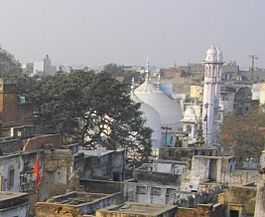Gyanvapi Mosque
| Gyanvapi Mosque | |
|---|---|
 | |
| Location | Varanasi, India |
| Architectural information | |
| Dome(s) | 2 |
| Minaret height | 72 m |
Gyanvapi Mosque or Alamgiri Mosque (Hindi: ज्ञानवापी मस्जिद "The Well of Knowledge"[1]) (Urdu: عالمگيری مسجد) is a mosque constructed by Mughal Emperor Aurangzeb. It is located north of Dashaswamedh Ghat, near Lalita Ghat along the river Ganges in Varanasi[2][3][4]
Construction

The minarets are 71 meters high and used to dominated the Varanasi skyline till a 1948 flood caused it to collapse.[5][6] Material from the destroyed temple was reused by Aurangzeb while building the Gyanvapi Mosque.[7] The mosque shows evidence of original Hindu temple in its foundation, columns and rear.[4][6] The old temple wall was also incorporated as part of the walls of the mosque. The deliberately retained remnants of the temple are described to be "a warning and an insult to Hindu feelings".[8] The façade is modeled on the Taj Mahal's entrance.[9]
The Kashi Vishwanath Temple was rebuilt in 1780 by the Hindu Maratha Queen Rani Ahilya-Bai Holkar besides the mosque and the two structures have existed in harmony since then, separated by a barricade of iron staves and chicken wire.[10] The Gyanvapi — the well of knowledge — is situated between the temple and the mosque. The well is believed by Hindus to be the location where the sacred Shiva linga icon of the temple was hidden, before the temple was razed by Aurangzeb.[7]
Concerns
After the demolition of the Babri Mosque on Ram Janmabhoomi Place by Hindu Karsevaks — who claim it was built on the site of a Hindu temple. [11] — in December 1992, about a thousand policemen guard the Kashi Vishwanath temple/Gyanvapi mosque site.[10] The mosque is functional and receives protection under Places of Worship (Special Provisions) Act, 1991.[12]
See also
References
- ↑ "Visit Varanasi - Vishwanath Temple".
- ↑ "Gyanvapi Mosque- Mughal mosque along the Ganges, Varanasi".
- ↑ Sanjeev Nayyar (September 9, 2010). "9/11, Ground Zero mosque, Babri & their symbolism". Daily News & Analysis (Mumbai: Diligent Media Corporation). DNA.
- ↑ 4.0 4.1 Siddharth Varadarajan (October 1, 2010). "Force of faith trumps law and reason in Ayodhya case". The Hindu (New Delhi: Kasturi & Sons Ltd. / The Hindu Group).
- ↑ "Dazzling India - Varanasi Mosques".
- ↑ 6.0 6.1 Footprint India By Roma Bradnock.
- ↑ 7.0 7.1 Good Earth Varanasi city guide by Eicher Goodearth Limited
- ↑ The Ashgate research companion to heritage and identity by Brian J. Graham, Peter Howard p.133
- ↑ Architecture of Mughal India, Part 1, Volume 4. Cambridge University Press. First published 1992. p. 278.
- ↑ 10.0 10.1 Sanjoy Majumder (March 25, 2004). "Cracking India's Muslim vote". BBC News (Uttar Pradesh).
- ↑ Saqi Must'Ad Khan (1947). Maasir-I-Alamgiri: A History of the Emperor Aurangzib-Alamgir. Royal Asiatic Society of Bengal, Calcutta.
- ↑ "Mosques will not be surrendered, says Babri panel". Indian Express (New Delhi: Indian Express Newspapers (Bombay) Ltd.). Press Trust Of India. September 15, 1999.
Coordinates: 25°18′40″N 83°00′38″E / 25.311229°N 83.010461°E

